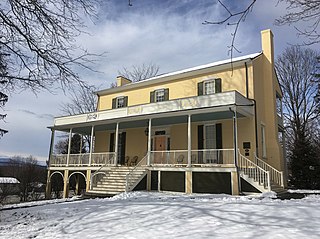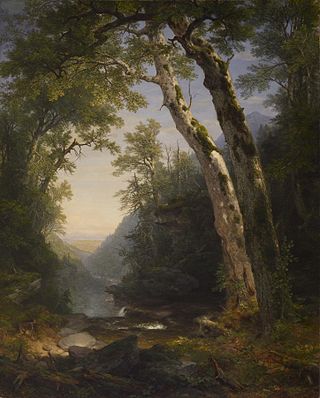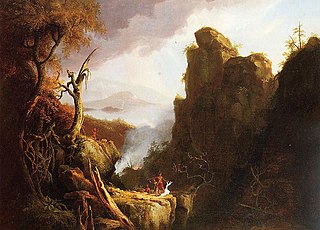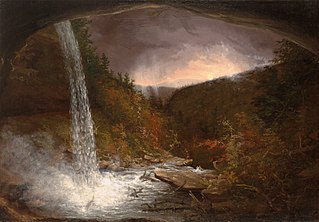
Frederic Edwin Church was an American landscape painter born in Hartford, Connecticut. He was a central figure in the Hudson River School of American landscape painters, best known for painting large landscapes, often depicting mountains, waterfalls, and sunsets. Church's paintings put an emphasis on realistic detail, dramatic light, and panoramic views. He debuted some of his major works in single-painting exhibitions to a paying and often enthralled audience in New York City. In his prime, he was one of the most famous painters in the United States.

The Hudson River School was a mid-19th-century American art movement embodied by a group of landscape painters whose aesthetic vision was influenced by Romanticism. Early on, the paintings typically depicted the Hudson River Valley and the surrounding area, including the Catskill, Adirondack, and White Mountains.

Thomas Cole was an English-born American artist and the founder of the Hudson River School art movement. Cole is widely regarded as the first significant American landscape painter. He was known for his romantic landscape and history paintings. Influenced by European painters, but with a strong American sensibility, he was prolific throughout his career and worked primarily with oil on canvas. His paintings are typically allegoric and often depict small figures or structures set against moody and evocative natural landscapes. They are usually escapist, framing the New World as a natural eden contrasting with the smog-filled cityscapes of Industrial Revolution-era Britain, in which he grew up. His works, often seen as conservative, criticize the contemporary trends of industrialism, urbanism, and westward expansion.

The Thomas Cole National Historic Site, also known as Cedar Grove, is a National Historic Landmark that includes the home and the studio of painter Thomas Cole, founder of the Hudson River School of American painting. It is located at 218 Spring Street, Catskill, NY, United States. The site provided Thomas Cole with a residence and studio from 1833 through his death in 1848.

The Catskills by Asher Brown Durand, an American engraver, portraitist, and landscape artist, was commissioned by William Thompson Walters in 1858.

Sarah Cole (1805–1857) was an American landscape painter and the sister of American landscape painter Thomas Cole. Although she was among the small group of early American female landscape painters, little is known about her life and few of her paintings are known to have survived.

Lake with Dead Trees, also known as Catskill, is an oil-on-canvas painting completed in 1825 by Thomas Cole. Depicting a scene in the Catskill Mountains in southeastern New York State, this work is one of five of Cole's 1825 landscapes that initiated the mid-19th century American art movement known as the Hudson River School.

Harriet Christina Cany Peale was an American landscape, portrait, and genre painter of the mid-nineteenth century. Although sometimes described as a copyist, a greater share of her oeuvre has been made public in recent years, allowing Cany Peale to earn recognition for her genre and landscape paintings. She has been located in contemporary scholarship as an artist of the Hudson River School.

Cross at Sunset is an oil on canvas painting by Thomas Cole. Believed to have been created around 1848, it was left unfinished due to his premature death that year.

Roman Campagna, also called Ruins of Aqueducts in the Campagna Di Roma, is an 1843 oil on canvas painting by Thomas Cole. It is currently displayed at the Wadsworth Atheneum in Connecticut.

The Last of the Mohicans: The Death of Cora, also known as Indian Sacrifice, is a c. 1827 painting by British-American painter Thomas Cole, the founder of the Hudson River School. The painting depicts the death of Cora from the 1826 American novel The Last of the Mohicans. It is one of four such paintings by Cole which depict scenes from the novel. The painting is currently owned by the University of Pennsylvania.

The Dead Abel is an 1832 oil-on-paper painting by British-American painter Thomas Cole, the founder of the Hudson River School. It depicts the dead biblical figure Abel. It was originally intended to be a study for a larger painting; however, this other work was never created.

Kaaterskill Falls is an 1826 oil-on-canvas painting by British-American painter Thomas Cole, founder of the Hudson River School. It depicts the Kaaterskill Falls in Upstate New York.

The Fountain of Vaucluse is an 1841 oil on canvas painting by British-American painter Thomas Cole, founder of the Hudson River School. The work depicts the former home of Petrarch in Fontaine-de-Vaucluse, France.

Il Penseroso is an 1845 oil on canvas painting by British-American painter Thomas Cole, founder of the Hudson River School. The work is currently possessed by the Los Angeles County Museum of Art. Il Penseroso means "the thoughtful" in Italian.

View of Fort Putnam is an 1825 oil-on-canvas painting of the Hudson River with a view of Fort Putnam by British-American painter Thomas Cole, who founded the Hudson River School. It is currently owned by the Philadelphia Museum of Art.

Genesee Scenery, also called Mountain Landscape with Waterfall, is an 1847 oil on canvas painting by British-born American painter Thomas Cole, founder of the Hudson River School. The work depicts the Genesee River in New York State.

Sunset, View on the Catskill is an 1833 oil-on-wood painting by English-born American painter Thomas Cole. It is currently owned by the New-York Historical Society.

Summer Twilight, A Recollection of a Scene in New-England is an 1834 oil-on-wood painting by British-born American painter Thomas Cole, the founder of the Hudson River School. It is currently owned by the New-York Historical Society.



















